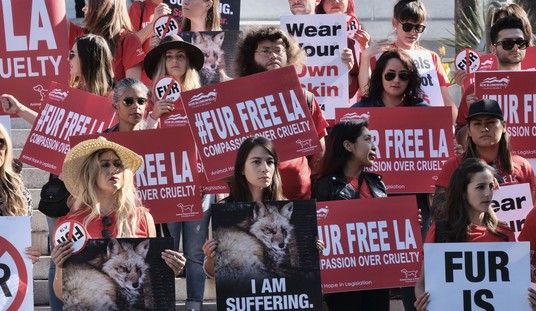The report says that the Dutch authorities fail to grasp the gravity of the problem. If nothing is done the country will soon witness situations similar to the French riots of 2005 and 2006 which led
to the police abandoning immigrant suburbs to gangs of Muslim youths. The result of the French ambivalence is that the same gangs have now taken over effective control of more than 750 French urban neighborhoods.
In response to the 2004 assassination of Theo van Gogh by a young Moroccan immigrant the Dutch minister of Integration, Rita Verdonk, installed four so-called “intervention teams for interethnic tensions.” The teams are made up of social workers whose task it is to advise local authorities on ways to deal with groups of unassimilated and criminal youths.
In major Dutch cities today many of the young people are not of indigenous Dutch extraction. In Amsterdam 55% of those under18 are immigrants, mainly Moroccan, Turkish or Antillean (West Indian). In Rotterdam the number has surpassed 50%.
Everywhere in the Netherlands this percentage is rising dramatically. This is paired with the fact that Dutch society has failed to inculcate the children of immigrants with Dutch values. In retrospect, perhaps the latter was simply impossible. There are 1 million Muslims on a total of 16 million inhabitants in the Netherlands. At over 6% of the population this is proportionally the largest Muslim immigrant population of all Western nations — except for France which has 6 million Muslims on a total of 60 million inhabitants. Overall these Muslims are younger than the indigenous population and tend to be concentrated in the cities.
Dick Corporaal, the coordinating president of the Dutch intervention teams, told Dutch national radio that “multicultural tensions between youths threaten to lead to an uncontrollable situation.” Corporaal warned that the problem is not restricted to cities but is also beginning to affect towns in the more rural areas. “The municipal authorities have no idea about what is going on.” He advised the government to devote more funds to youth work and to increase the number of intervention teams. He also accused the local authorities of treating all troublesome youths similarly, while according to him different approaches are needed when confronting the various groups: Moroccans, Antilleans, Turks and “Lonsdale youths” [The latter are indigenous Dutch hooligans].
The intervention teams recommend a similar expansion of the “social worker approach” to defuse the situation. This is a typically Dutch way of doing things, which is widely applied, even among Dutch troops in Afghanistan who prefer to have tea with the Taliban rather than fight them.
Last year the police of The Hague sent officers on a “cultural training” trip to Morocco because, as Gerard Bouman, the The Hague police chief, said, “Criminal Moroccan youths […] do not behave like indigenous Dutch. They rave about Moroccan culture. Hence, we have to know the latter, too.” In Morocco, the Dutch police officers discovered that their Moroccan colleagues were astonished to hear that the Dutch have problems with criminal Moroccan youths. In Morocco officers just beat the hell out of criminals.
Corporaal’s tepid recommendations, however, do not seem to go down well with many ordinary native Dutch. A poll conducted by Elsevier, the largest Dutch weekly, indicates that 80% of its readers prefer a “harsh treatment” of troublemaking youths rather than “sending in more multicultural intervention teams.”
Meanwhile, in order to reduce tensions between immigrant youths and white native hooligans, a Dutch high school, Hoofdvaart College in Hoofddorp, which lies between Amsterdam and Haarlem, has prohibited the wearing of Lonsdale cloths by pupils.
Lonsdale is a British clothing brand whose sweaters and jackets are said to be popular with the far right because the brand name includes the letters NSDA, one letter short of NSDAP, the German acronym for Hitler’s Nazi Party. According to the school, wearing Lonsdale is a “provocation and is offensive to others.” Two years ago, however, a report of the Dutch state security services found that the majority of those wearing Lonsdale gear are not far right fanatics.
The official Dutch worries about rising hostility in immigrant communities towards the hitherto predominant culture in the Netherlands are also discernible in the fifth annual report of Tjibbe Joustra, the National Anti-Terrorism Coordinator. Late last month the government submitted the report to the Dutch Parliament. Joustra writes that he is especially worried about the rise in so-called “living room marriages” (informal Islamist weddings conducted at home).
This phenomenon is “more widespread” than previously thought, the report says. Last week Joustra’s spokesman said “We knew these weddings occurred in certain circles, but we have indications that they are also on the rise elsewhere.” He referred to a growing group of underage Dutch girls, 16 or 17 years old, who convert to Islam in order to marry young Muslim men with whom they have fallen in love. “The women get isolated from their families. The isolation leads to radicalization.” The report of the National Anti-Terrorism Coordinator says there were a number of “living room marriages” within the Hofstad Group, the circle around Mohammed Bouyeri, Theo van Gogh’s assassin.
Joustra’s report sees the rise of “living room marriages” as one of many indications of the growth of radical Islamism, especially Salafism, in the Netherlands. According to Joustra Salafists are very active among youth groups in the main Dutch cities, but also increasingly in other parts of the country. “We are aware now that young people can radicalize very fast,” Joustra’s spokesman said. “This can happen within a couple of months.”
The growing number of incidents, the reports from social workers and police authorities, are all warnings that the dykes of multiculturalism are about to break and that something must urgently be done to avoid a violent clash. So far, however, apart from forbidding the wearing of certain clothes, the Dutch do not seem to know how to stop the rising tide of fanaticism.
Dr Paul Belien, a Brussels-based writer, is Director of Islamist Watch and an Adjunct Fellow of The Hudson Institute. Many of his articles and reports can be found @ The Brussels Journal.









Join the conversation as a VIP Member